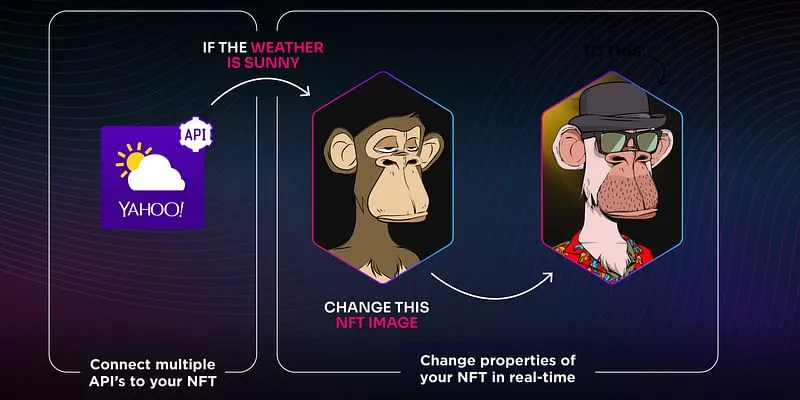Make your bored ape wear a hat: Meet the startup making infinitely customisable NFTs
Co-founded by Anil Dukkipatty and Raunaq Vaisoha, Revise helps developers transform their static NFTs into interactive ones to adapt to apps and real-world events.
As non-fungible tokens (NFTs) gain popularity across social media, music, sports, and gaming, the relatively niche market has now crossed the $7 billion market capitalisation. Many Web3 enthusiasts are also turning towards programmable NFTs, which transform a static JPEG NFT into a multimedia entity.
Anil Dukkipatty and Raunaq Vaisoha, buoyed by the belief that NFTs were beyond static images, decided to build programs that could add utility to them. In January 2022, the duo co-founded NFT startup Revise to help developers transform their static NFTs into interactive ones to adapt to apps and real-world events.
In a conversation with The Decrypting Story, Raunaq explains that "while NFTs have become quite commonplace, it is only a matter of time before the market wants more than just static JPEG images."
He adds that NFT collections are already experiencing a “saturation”. “They are unable to mint their NFTs because they are merely profile pictures. Utility and gaming are necessary to make NFTs a part of larger projects. You can only accomplish this by programming them to be a component of a larger system.”
It is this programmability that Revise enables so that NFTs can become utilities and gaming assets. “You have an NFT, we allow developers to write a program that allows users to connect it to apps,” says Raunaq.

Programmable NFTs
The startup is also adding an audit trail for all revisions made to an NFT based on the programming structure so a developer can handle dispute resolution in a trustable and seamless manner. It adds a layer of governance for the storage through its data.
“Revise aims to build a fundamental layer for NFT provenance and programming,” he adds.
Advertising in the metaverse
Recently, Revise teamed up with metaverse platform WeMeta to launch NFT billboards to advertise in the metaverse.
Anil explains, “For instance, if there is an event or a party in the metaverse, content on the billboards will be updated regularly based on the number of people attending the event or party. As more people attend, higher premium advertisements will be displayed on billboards.”
The metaverse will also have its own distinctive ad forms with marketing attribution so marketers can monitor traffic and make wise investments.

Billboards in metaverse
Raunaq adds, “The NFT-powered billboards will display advertisements in any metaverse and are primarily composed of images. Using Revise’s dynamic NFT infrastructure, WeMeta will generate links for the photos to embed the advertisements and it will make sure that these links always point to the most recent versions of the images.”
He explains that these billboards are one of the tools to promote ads in the metaverse. “To simplify it further, WeMeta’s API will analyse the footfall in the event so that businesses can place advertisements in the metaverse. As the footfall updates, users can sell brackets of advertising. Purchasing the NFT billboard from the appropriate metaverse will be profitable for the user.”
The founders say that this would be a new way of earning money for NFT creators. Creators currently earn revenue on NFTs through royalties, i.e., when a new buyer buys one.
“However, by turning static NFTs into dynamic, creators could embed advertisements on them, draw brands, and open up a new revenue stream” adds Raunaq.
Advertising in the metaverse is considered to be the next big thing, as it will pave way for new revenue streams. The metaverse would also offer an innovative marketing medium for brands to build in the future.
A Bloomberg report says that the metaverse will be nearly an $800-billion market by 2024. Hence, there is indisputable potential for brands to use it as a marketing platform. In fact, businesses are raising millions of dollars with the aim of supporting the metaverse, including tech giants Meta, Apple, Google, and Microsoft.
On the other hand, online gaming platforms like Roblox and Fortnite have become popular destinations for marketers to connect with digital natives to sell their virtual goods. Sandbox, Decentraland, and Bloktopia are popular metaverses while global brands including Nike, Gucci, and Adidas are exploring ways to promote their products in the metaverse.
The way ahead
According to reports by Market Watch, the global NFT market size is projected to reach $7,390.8 million by 2028, at a CAGR of 24.4 percent.
At present, Revise SDK is live on NPM (node package manager) and developers can sign up for their private beta mode to use it.
In April, the startup raised seed funding of $3.5 million led by AlphaWave Global and 8i. Investors, including Bharat Founders Fund, Sandeep Nailwal (Co-founder of Polygon), Scott Lewis (Founder of Defi Pulse), Utsav Somani (AngelList), and Rahul Chaudhary (Co-founder of Treebo) were also part of the seed round.
The US-based startup has a team of seven and plans to expand this soon.
“Today, billions know about NFTs and only 360,000 individuals own them. We are going to see innovation and growth in NFT in the coming years. We are going to see programming NFTs in the future and we saw this happening six months ago and there are bunch of projects that are building using Revise’s automation and we have many collaborations lined up for the future.” Raunaq concludes.
(This story was updated to reflect the latest number of total NFT owners.)
Edited by Saheli Sen Gupta









